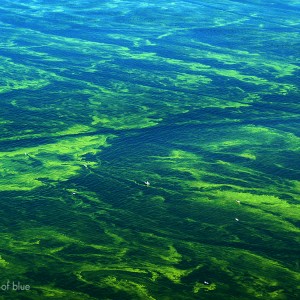Federal Water Tap, March 3: California Dam, Alaska Mine, Lake Erie Algae
Building a long-debated reservoir in the Sierra Nevada foothills 40 kilometers (25 miles) northeast of Fresno would improve river habitat for salmon but would provide little additional water for farmers and cities, according to a Bureau of Reclamation feasibility report.
The $US 2.6 billion Temperance Flat Dam would create a reservoir with a capacity of 1.2 million acre-feet (1.5 billion cubic meters), roughly 2.5 times larger than Millerton Lake, the largest reservoir on the San Joaquin.
But the amount of water made available to farmers and cities would be far less. The dam would increase the average annual supply by only 61,000 acre-feet to 76,000 acre-feet (75 million cubic meters to 94 million cubic meters) because of water supply restrictions designed to help salmon and the Sacramento-San Joaquin Delta. In critically dry years, such as this one, the average supply would be roughly two-thirds lower, equal to what a handful of large alfalfa farmers use annually.
The report argues that in seven out of eight scenarios the benefits of the $US 2.6 billion project outweigh the costs, but the analysis relies on assumptions about rejuvenated salmon runs to justify the dam, which would boost river flows and decrease water temperatures to a range acceptable to the fish.
Sharon McHale, a Bureau of Reclamation project manager for the San Joaquin River, told Circle of Blue she did not know of any other Reclamation dam built primarily for an environmental purpose.
Reclamation analyzed two fish development cycles for four options, all of which involve building Temperance Flat, a project first studied in the 1930s. Each of the options, which differ according to the dam’s physical structure and how it would be operated, was compared against not building the dam.
The two primary goals for the project, which is now undergoing an environmental review due in July, are to increase water supply and to revive salmon runs in the San Joaquin River. Secondary goals emphasize storing more flood waters, maintaining hydropower generation capacity, increase recreational opportunities, and improve water quality.
EPA Moves to Veto Alaskan Mine
Invoking a rarely used power in the Clean Water Act, the U.S. Environmental Protection Agency moved to block a controversial mining project in Alaska on the grounds that the mine would do irreparable harm to one of the world’s top salmon fisheries.
The EPA is invoking Section 404(c) of the Clean Water Act, which gives the agency authority to deny a construction permit for any activity that would significantly harm watersheds or wildlife, two justifications EPA administrator Gina McCarthy used in requesting the veto action.
“Extensive scientific study has given us ample reason to believe that the Pebble Mine would likely have significant and irreversible negative impacts on the Bristol Bay watershed and its abundant salmon fisheries,” McCarthy said.
“It’s why EPA is taking this step forward in our effort to ensure protection for the world’s most productive salmon fishery from the risks it faces from what could be one of the largest open pit mines on earth. This process is not something the agency does very often, but Bristol Bay is an extraordinary and unique resource.”
Since 1972, the EPA has used a Section 404(c) veto just 13 times.
In January 2014, the EPA released a peer-reviewed scientific assessment of the mining proposal. The study found that developing the Pebble mine site would fundamentally alter the region’s ecology and Alaskan native society.
The EPA will now hear public comments on its decision and consult with the Army Corps of Engineers, a process that will last six months at a minimum.
Algae Limits Proposed
Stricter limits on phosphorous are needed to keep Lake Erie free from toxic algae and principles of common law should be used to rewrite regulations, according to a report from the commission that oversees the Great Lakes and other waters shared by the United States and Canada.
The International Joint Commission recommended a 46 percent reduction in the average annual phosphorous load in Lake Erie’s western and central basins, and suggested using the public trust doctrine to do so. Public trust doctrine argues that certain resources should be protected for the community.
Algae blooms, fed by warm temperatures and too many nutrients in the water, have recently plagued the shallowest of the Great Lakes. The blooms also suck oxygen out of the water, suffocating fish.
Colorado Pipeline
The Bureau of Reclamation approved a water supply pipeline to serve 40 small towns in southeast Colorado.
The federal government will pay for 65 percent of the $US 400 million conduit. Local users will pick up the balance.
Federal Water Tap is a weekly digest spotting trends in U.S. government water policy. To get more water news, follow Circle of Blue on Twitter and sign up for our newsletter.
Brett writes about agriculture, energy, infrastructure, and the politics and economics of water in the United States. He also writes the Federal Water Tap, Circle of Blue’s weekly digest of U.S. government water news. He is the winner of two Society of Environmental Journalists reporting awards, one of the top honors in American environmental journalism: first place for explanatory reporting for a series on septic system pollution in the United States(2016) and third place for beat reporting in a small market (2014). He received the Sierra Club’s Distinguished Service Award in 2018. Brett lives in Seattle, where he hikes the mountains and bakes pies. Contact Brett Walton





Leave a Reply
Want to join the discussion?Feel free to contribute!